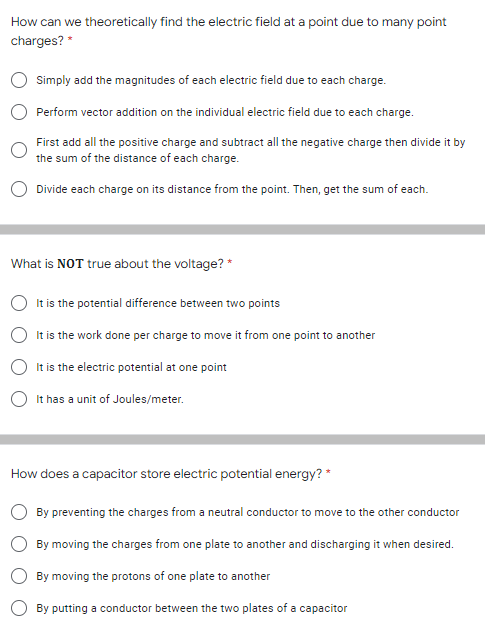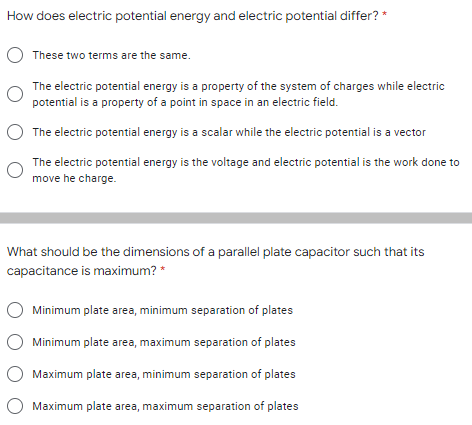How can we theoretically find the electric field at a point due to many point charges? O Simply add the magnitudes of each electric field due to each charge. Perform vector addition on the individual electric field due to each charge. First add all the positive charge and subtract all the negative charge then divide it by the sum of the distance of each charge. Divide each charge on its distance from the point. Then, get the sum of each. What is NOT true about the voltage? " O It is the potential difference between two points O It is the work done per charge to move it from one point to another O It is the electric potential at one point O It has a unit of Joules/meter.
How can we theoretically find the electric field at a point due to many point charges? O Simply add the magnitudes of each electric field due to each charge. Perform vector addition on the individual electric field due to each charge. First add all the positive charge and subtract all the negative charge then divide it by the sum of the distance of each charge. Divide each charge on its distance from the point. Then, get the sum of each. What is NOT true about the voltage? " O It is the potential difference between two points O It is the work done per charge to move it from one point to another O It is the electric potential at one point O It has a unit of Joules/meter.
Chapter5: Electric Charges And Fields
Section: Chapter Questions
Problem 101P: In this exercise, you practice electric field lines. Make sure you represent both the magnitude and...
Related questions
Question

Transcribed Image Text:How can we theoretically find the electric field at a point due to many point
charges? *
Simply add the magnitudes of each electric field due to each charge.
Perform vector addition on the individual electric field due to each charge.
First add all the positive charge and subtract all the negative charge then divide it by
the sum of the distance of each charge.
Divide each charge on its distance from the point. Then, get the sum of each.
What is NOT true about the voltage? *
It is the potential difference between two points
It is the work done per charge to move it from one point to another
It is the electric potential at one point
It has a unit of Joules/meter.
How does a capacitor store electric potential energy? *
By preventing the charges from a neutral conductor to move to the other conductor
By moving the charges from one plate to another and discharging it when desired.
By moving the protons of one plate to another
By putting a conductor between the two plates of a capacitor

Transcribed Image Text:How does electric potential energy and electric potential differ? *
These two terms are the same.
The electric potential energy is a property of the system of charges while electric
potential is a property of a point in space in an electric field.
O The electric potential energy is a scalar while the electric potential is a vector
The electric potential energy is the voltage and electric potential is the work done to
move he charge.
What should be the dimensions of a parallel plate capacitor such that its
capacitance is maximum? *
Minimum plate area, minimum separation of plates
Minimum plate area, maximum separation of plates
Maximum plate area, minimum separation of plates
Maximum plate area, maximum separation of plates
Expert Solution
This question has been solved!
Explore an expertly crafted, step-by-step solution for a thorough understanding of key concepts.
Step by step
Solved in 2 steps

Knowledge Booster
Learn more about
Need a deep-dive on the concept behind this application? Look no further. Learn more about this topic, physics and related others by exploring similar questions and additional content below.Recommended textbooks for you


Principles of Physics: A Calculus-Based Text
Physics
ISBN:
9781133104261
Author:
Raymond A. Serway, John W. Jewett
Publisher:
Cengage Learning

College Physics
Physics
ISBN:
9781938168000
Author:
Paul Peter Urone, Roger Hinrichs
Publisher:
OpenStax College


Principles of Physics: A Calculus-Based Text
Physics
ISBN:
9781133104261
Author:
Raymond A. Serway, John W. Jewett
Publisher:
Cengage Learning

College Physics
Physics
ISBN:
9781938168000
Author:
Paul Peter Urone, Roger Hinrichs
Publisher:
OpenStax College

Physics for Scientists and Engineers with Modern …
Physics
ISBN:
9781337553292
Author:
Raymond A. Serway, John W. Jewett
Publisher:
Cengage Learning

Physics for Scientists and Engineers, Technology …
Physics
ISBN:
9781305116399
Author:
Raymond A. Serway, John W. Jewett
Publisher:
Cengage Learning

Physics for Scientists and Engineers: Foundations…
Physics
ISBN:
9781133939146
Author:
Katz, Debora M.
Publisher:
Cengage Learning